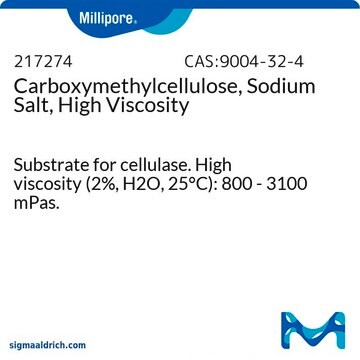If this product has an expiration or retest date, it will be shown on the Certificate of Analysis (COA, CofA). If there is no retest or expiration date listed on the product's COA, we do not have suitable stability data to determine a shelf life. For these products, the only date on the COA will be the release date; a retest, expiration, or use-by-date will not be displayed.
For all products, we recommend handling per defined conditions as printed in our product literature and website product descriptions. We recommend that products should be routinely inspected by customers to ensure they perform as expected.
For products without retest or expiration dates, our standard warranty of 1 year from the date of shipment is applicable.
For more information, please refer to the Product Dating Information document: https://www.sigmaaldrich.com/deepweb/assets/sigmaaldrich/marketing/global/documents/449/386/product-dating-information-mk.pdf
419338
Sodium carboxymethyl cellulose
average Mw ~700,000
Synonyme(s) :
Carboxymethylcellulose sodium salt
About This Item
Produits recommandés
Forme
powder
Température d'inflammation spontanée
698 °F
Poids mol.
average Mw ~700,000
Ampleur du marquage
0.9 carboxymethyl groups per anhydroglucose unit
Pf
270 °C (dec.)
Chaîne SMILES
[Na].OC(C(O)C(O)C=O)C(O)CO.OC(=O)C
InChI
1S/C6H12O6.C2H4O2.Na/c7-1-3(9)5(11)6(12)4(10)2-8;1-2(3)4;/h1,3-6,8-12H,2H2;1H3,(H,3,4);
Clé InChI
DPXJVFZANSGRMM-UHFFFAOYSA-N
Vous recherchez des produits similaires ? Visite Guide de comparaison des produits
Description générale
Application
Code de la classe de stockage
11 - Combustible Solids
Classe de danger pour l'eau (WGK)
WGK 1
Point d'éclair (°F)
Not applicable
Point d'éclair (°C)
Not applicable
Équipement de protection individuelle
Eyeshields, Gloves, type N95 (US)
Faites votre choix parmi les versions les plus récentes :
Déjà en possession de ce produit ?
Retrouvez la documentation relative aux produits que vous avez récemment achetés dans la Bibliothèque de documents.
Les clients ont également consulté
-
How can I determine the shelf life / expiration / retest date of this product?
1 answer-
Helpful?
-
-
How is shipping temperature determined? And how is it related to the product storage temperature?
1 answer-
Products may be shipped at a different temperature than the recommended long-term storage temperature. If the product quality is sensitive to short-term exposure to conditions other than the recommended long-term storage, it will be shipped on wet or dry-ice. If the product quality is NOT affected by short-term exposure to conditions other than the recommended long-term storage, it will be shipped at ambient temperature. As shipping routes are configured for minimum transit times, shipping at ambient temperature helps control shipping costs for our customers. For more information, please refer to the Storage and Transport Conditions document: https://www.sigmaaldrich.com/deepweb/assets/sigmaaldrich/marketing/global/documents/316/622/storage-transport-conditions-mk.pdf
Helpful?
-
-
Is this compound suitable for In vivo work?
1 answer-
This product has not been tested for in vivo or in vitro use. However, based on a review of the peer-reviewed papers, this material has been used in animal models. Please see the link below to review this publication: https://onlinelibrary.wiley.com/doi/10.1002/adhm.201400250
Helpful?
-
-
I am trying to buy CMC that is the same as the one used in batteries, but I am not sure how the Molecular weight would affect its properties. would it matter if it was high or low?
1 answer-
Carboxymethyl Cellulose Sodium serves as a binder for electrode materials in batteries. The molecular weight is irrelevant as long as all the components (active material, binder, conductive agent) can be immobilized on the current collector without obvious agglomeration or exfoliation. One reference suggested that lower molecular weight CMC produced 'lower charge transfer resistance, higher ion conductivity, better wettability with the electrolyte, and better Li+ mobility as LIB binder.' Should a lower molecular weight material be of interest, see CMC product 419274, average Mw ~90,000. See the links below to review this product page as well as the reference cited above.
419273, Sodium Carboxymethyl cellulose
https://www.sigmaaldrich.com/product/aldrich/419273Assembly and electrochemical testing of renewable carbon-based anodes in SIBs: A practical guide
https://www.sciencedirect.com/science/article/pii/S209549562200479XSodium carboxymethyl cellulose as a potential binder for hard-carbon negative electrodes in sodium-ion batteries
https://www.sciencedirect.com/science/article/pii/S1388248114001209Helpful?
-
Active Filters
Notre équipe de scientifiques dispose d'une expérience dans tous les secteurs de la recherche, notamment en sciences de la vie, science des matériaux, synthèse chimique, chromatographie, analyse et dans de nombreux autres domaines..
Contacter notre Service technique
![Poly[(o-cresyl glycidyl ether)-co-formaldehyde] average Mn ~870](/deepweb/assets/sigmaaldrich/product/structures/492/686/3e332037-f67b-49a2-8326-268fc7b0b900/640/3e332037-f67b-49a2-8326-268fc7b0b900.png)


